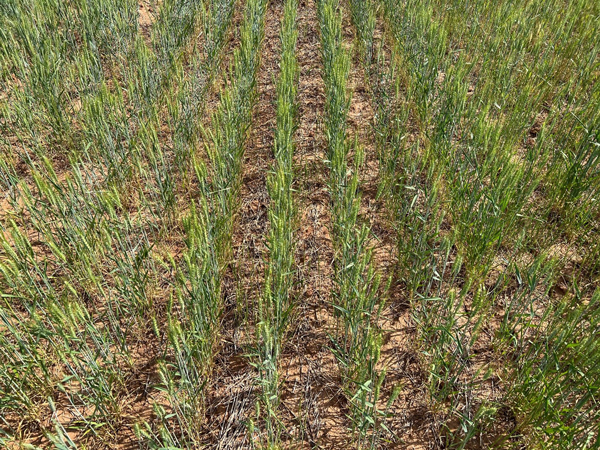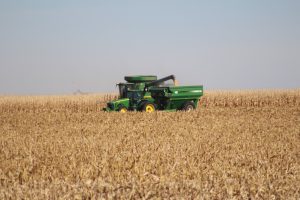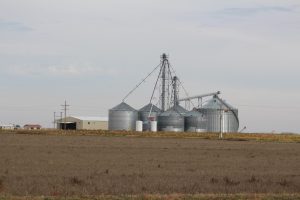KSU Agronomy shares considerations when harvesting short wheat

In many areas of Kansas, prolonged drought has resulted in short wheat and thin stands (Figure 1). Harvesting wheat in these situations can be a challenge. Special attention needs to be given to cutting height, machine adjustments, and operator control. In short wheat, getting the heads into the combine with less straw will be challenging. In some cases, the reel may not be able to effectively convey the wheat back from the cutter bar to the auger nor hold it in place during cutting. Short cutting will also mean more contact potential with the ground and reduced levels of surface residue which will likely negatively impact moisture storage.

Figure 1. Typical wheat height and stand density in drought-affected areas of Kansas during the 2022-23 winter wheat growing season. Photo by Romulo Lollato, K-State Research and Extension.
In the case of material conveyance, stripper headers, air reels, and draper headers may be a great help.
Stripper headers
Stripper headers allow the grain to be harvested efficiently while leaving the maximum amount of standing residue in the field. Research has shown that this preservation of wheat residue can reduce evaporative losses of water after harvest, aid in the moisture retention of snow, and improve the yields of the next year’s crop.
To properly use a stripper header, note the following:
- Operators need to be aware of the stripping rotor height and the relative position of the hood to the rotor. This position needs to be set correctly so that heads approach the rotor at the proper angle for stripping.
- Keep the nose of the hood orientated so that the top of the wheat heads are even with, or slightly below, the forward point of the nose. This may require operating the header with the nose in a slightly lower-than-normal position relative to the rotor. However, it’s important to note that running a stripper header lower than necessary will result in increased power consumption and accelerated finger wear.
- Combine ground speeds should be kept high (above 4 mph) to maintain collection efficiency and minimize header losses.
- Several people have reported that adjusting header height with a stripper header is not as critical as it is with a conventional header and that a stripper header could easily be run by inexperienced people (see step 1).
- Continue to adjust stripping rotor speed throughout the day as conditions change. If rotor speeds are too high, that will result in detachment of the entire head and unnecessary increases in power requirements. Rotor speeds that are too slow will result in unstripped grain remaining in the head. In general, rotor speeds will be less in thin, short wheat than in better stands.
Air reels
Air reels will also aid in the material conveyance from the cutter bar to the auger in reel-type units when crops are light or thin. These units are made in several different types, including finger air reels, non-reel, and units that fit over existing reels. Examples of manufacturers are Crary (West Fargo, ND) and AWS (Mitchell, Ontario, Canada). Non-reeled units have the advantage of less eye strain from the continuously rotating header reel, but all units have collection efficiencies compared to conventional reels, even in sparse or short crops. These units do not control the amount of wheat stubble left in the field, and the operator still has to control the cutting height. In short wheat this may mean little to no field stubble will be left for next season’s moisture collection, and for these reasons stripper headers may be a better choice for certain areas of Kansas.
Draper headers and flex heads
Draper headers may help with the conveyance of material since they have a very short distance between the cutterbar and the conveyance belt. The ability to tip the cutterbar completely back will aid in keeping harvested crop material moving across the cutter bar and onto the belt as well as ensuring some stubble remains standing on the soil surface. Cleats on the belt need to be in good to new condition to maximize the conveyance of crop material away from the cutterbar. Set gauge wheels properly to maximize cutting height and leave standing residue.
Flex heads will also help deal with the lower cutting heights and potential ground strikes. In thin wheat stands, it is even more important that sickles and guards are in good condition as there is less crop material pushing into the cutting area, which would normally help ensure cutting by worn sickles and guards. On headers with finger reels, it is quite likely that the short cut wheat will pass in between the fingers rather than being swept backward. Producers may consider adding material over or behind the fingers to act more as a bat to sweep the cutterbar clean. Plastic/vinyl materials or repurposed round baler belting has been successfully used for this purpose.
If harvesting with a draper or flex header, maintain the cutting height as high as possible to preserve standing stubble. Typically, cutting wheat at two-thirds of its full height will result in losses of less than 0.5 percent, as any missed heads contain lightweight grain that will be lost as tailings during harvesting.
Conventional headers
For many farmers, new equipment may not be an economical choice, and you may have to work with a conventional head on your combine. In this case, adjust the reel to get the best movement of the heads from the cutter bar to the auger. Combining in slightly damp conditions may help prevent shatter and decrease losses. If wheat heads have flipped out of the header from the top of the auger, an extra “auger stripper bar” may be necessary. A small strip of angle iron can be bolted slightly behind and below the auger to help with material conveyance. In thin wheat stands it is even more important that sickles and guards are in good condition as there is not as much crop material to push into the cutting area and ensure cutting by worn sickles and guards.
If harvesting with a conventional header, maintain the cutting height as high as possible to preserve standing stubble. Typically, cutting wheat at two-thirds of its full height will result in losses of less than 0.5 percent, as any missed heads contain lightweight grain that will be lost as tailings during the harvesting process.
Combine adjustments
In addition to material conveyance and cutting height, lower yields and uneven crop flow may also require performing combine adjustments to the concave/rotor cage clearance, cylinder/rotor speed, and fan speed. Follow the manufacturer’s recommendations. The leading cause of grain damage under almost any harvesting condition is an overly fast cylinder or rotor speed. This will especially be evident in harvesting short wheat as there will be less material in the concave or rotor cage to thresh against, increasing the likelihood of grain damage if cylinder/rotor speed is too high.
On conventional machines, it may be necessary to reduce concave clearance to attain good separation. On rotary combines it may be advantageous to maintain a typical clearance to provide a more normal threshing condition while using less threshing area. The use of blanking plates on the rotor cage may improve separation. Fan speeds may need to be reduced slightly in order to minimize grain losses. Once adjusted properly, try to keep material crop flow as constant as possible, as most threshing and cleaning units work best under these constant flow conditions. As the amount of material passing through the combine decreases, the response to various settings such as cylinder/rotor speed, concave/rotor cage clearance, and fan speed will be more sensitive than under more normal operating conditions.
Performing kill-stops during harvest will be especially critical in evaluating grain losses and identifying which stage of the harvesting process is the source. After performing a kill-stop the operator should look at shattered grain losses before the header, losses after the header and before the spread pattern of the combine, and losses in the tailings behind the combine. Losses can be quickly checked by looking at the number of seeds in the tailings and elsewhere around the combine.
Typically, 20 seeds per square foot equals 1 bushel per acre for a sampling area equal to the cutting width of the combine. For the tailings area, where the material is concentrated, multiply the 20 seeds per square foot by the header-to-tailings width ratio. For example, a combine with a 7-foot spreader width and 28-foot header would have a factor of 4 (28 divided by 7), and 80 seeds per square foot (20 x 4) would be the correct number for a bushel-per-acre loss. Also, a normal shoe length is typically one foot, so estimated measurements can be done with your foot. Individual field and header losses are determined by looking at areas before and under the combine. Actual combine threshing losses are determined by subtracting these numbers from the tailing loss.
Summary
Although this will be a rough wheat harvest for many farmers, some changes can be made to help maximize harvest efficiencies. If you have ever wanted to try an alternate header (stripper, flex-draper, etc.), this may be the year for you. For those not wanting to buy, renting may also be a viable option.
Producers in dryland production systems need to remember that in very low-yielding wheat years, anything that can be done to preserve the little crop residue present will have a large impact on evaporative losses and the productivity of the next crop.
Lucas Haag, Northwest Area Crops and Soils Specialist
lhaag@ksu.edu
Ajay Sharda, Extension Biological and Agricultural Engineer
asharda@ksu.edu
Romulo Lollato, Wheat and Forage Specialist
lollato@ksu.edu
John Holman, Cropping Systems Agronomist – Southwest Research and Extension Center
jholman@ksu.edu









